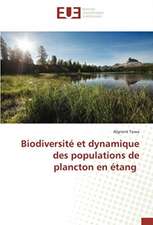Emergency Care for Birds: A Guide for Veterinary Professionals
Autor Rob van Zonen Limba Engleză Paperback – 6 dec 2023
This full-color book, packed with photographs and anatomy drawings, includes instructions for veterinary professionals on stabilizing sick avian patients and management of many specific emergency situations at the veterinary clinic. This includes guidance for those presented with a moribund, critically ill patient i.e., recognizing and treating hypothermia, hypoxia, hypovolemia and hypoglycemia. The book also lists of alarming signs of disease and toxic plants, and includes clinical procedures, an emergency drug formulary, and bandaging techniques. Finally, it offers guidance to veterinarians giving advice to bird owners for first aid at home.
Toate formatele și edițiile
| Toate formatele și edițiile | Preț | Express |
|---|---|---|
| Paperback (1) | 383.22 lei 3-5 săpt. | +19.58 lei 6-12 zile |
| CRC Press – 6 dec 2023 | 383.22 lei 3-5 săpt. | +19.58 lei 6-12 zile |
| Hardback (1) | 908.51 lei 6-8 săpt. | |
| CRC Press – 6 dec 2023 | 908.51 lei 6-8 săpt. |
Preț: 383.22 lei
Preț vechi: 416.55 lei
-8% Nou
Puncte Express: 575
Preț estimativ în valută:
73.33€ • 76.41$ • 60.72£
73.33€ • 76.41$ • 60.72£
Carte disponibilă
Livrare economică 14-28 martie
Livrare express 27 februarie-05 martie pentru 29.57 lei
Preluare comenzi: 021 569.72.76
Specificații
ISBN-13: 9781032311326
ISBN-10: 1032311320
Pagini: 260
Ilustrații: 4 Tables, color; 151 Line drawings, color; 151 Illustrations, color
Dimensiuni: 156 x 234 x 16 mm
Greutate: 0.42 kg
Ediția:1
Editura: CRC Press
Colecția CRC Press
ISBN-10: 1032311320
Pagini: 260
Ilustrații: 4 Tables, color; 151 Line drawings, color; 151 Illustrations, color
Dimensiuni: 156 x 234 x 16 mm
Greutate: 0.42 kg
Ediția:1
Editura: CRC Press
Colecția CRC Press
Public țintă
Professional, Professional Practice & Development, Professional Reference, Professional Training, and Undergraduate AdvancedNotă biografică
Having been interested in birds throughout his whole youth, Rob van Zon started studying veterinary medicine at the University of Utrecht to turn his passion into his job. After graduating in 2005, Rob worked as avian veterinarian in veterinary practices in Amsterdam and Utrecht and in avian wildlife centers in the Netherlands. In addition to treating thousands of birds in his own clinics, Rob tries to help as many birds as possible indirectly by teaching other veterinarians, students and bird owners.
Cuprins
Part 1: Acute clinical signs of disease. 1. Clinical signs of disease. 2. Signs of disease requiring immediate attention by a veterinary professional. Part 2: Birds as emergency patients at the veterinary clinic. 3.Observation, physical examination and diagnostic tests. 4. General stabilization of sick birds. 5. Heat. 6.Fluid therapy. 7. Nutritional support. 8. Oxygen. 9. Analgesia and anesthesia.10. Quick guide for stabilizing birds in case of severe dyspnea, debilitation and shock Part 3: Specific emergency situations. 11. Leg band constriction. 12. Bleeding pin feather. 13. Hyperthermia. 14. Bleeding nail or beak tip. 15. Perforating (bite) trauma of the beak. 16. Lacerations and cuts. 17. Bite wound or deep wound caused by claws. 18. Self-mutilation. 19. Burn injuries. Contact with glue from rodent or insect trap. 20. Oil contamination. 22. Intoxications. 23. Concussion. 24. Cloacal prolapse. 25. Vomiting. 26. Crop stasis. 27. Seizures. 28. Egg binding / Dystocia. 29. Dyspnea. 30. Falling, abnormal stances and abnormal movements. 31. Paralysis. 32. Abnormal eye or closed eyelids (inability or unwillingness to open the eye). 33. Abnormal position of limbs. Fractures and luxations. 34. Maxillary hyperextension/palatine bone luxation. 35. Abnormal droppings. 36. Damaged air sac. Appendices. A1 Technique: Handling of birds. A2 Technique: Subcutaneous, intravenous and intrasosseous infusion, and venipuncture. A3 X-rays. A4 Microscopic examination of feces. A5 Technique: Placement of crop tube and crop lavage. A6 Technique: Placement of air sac tube. A7 Technique: Imploding eggs. A8 Technique: Applying (splint) bandages. A9 Technique: Ingluviotomy. A10 Table of (possibly) poisonous plants. A11 Psittacosis. A12 Disorders of calcium metabolism. A13 First-aid kit at home. A14 Extra ‘avian’ veterinary materials. A15 Formulary. A16 Biochemistry reference intervals. A17 Anatomy.
Descriere
This concise, practical guide will help veterinary professionals to provide first aid and emergency care for birds, as well as to instruct clients on providing basic first aid when they are unable to get to the clinic.
















